
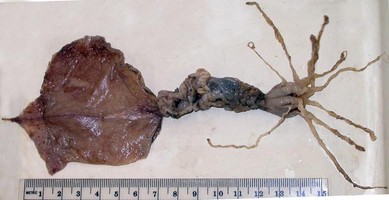
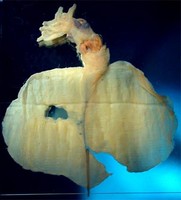
Figure. Ventral views of the two specimens of M. atlantica from which the beaks were examined. Left - 127 mm ML, mature male. Right - 53 mm ML, paratype, juvenile male.
Lower Beak
Mature male, 127 mm ML: Shoulder with sharp wing-fold covering jaw angle and extending onto rostrum; lateral wall esentially flat, lateral-wall fold barely detectible, ie, virtually absent; jaw angle acute, low rounded tooth on one side, eroded on other side; rostrum short with constriction near tip; beak shape low and broad; Height/length (c/d) = 0.6; LRL = 1.6 mm (measured to inner edge of medial shoulder blade). Wing length/outer rostral length (b/a) = 4.3. Wing angle = 100°. Hood to crest ratio = 0.67. Crest to base ratio = 0.63. Rostral base/baseline = 0.15. Hood close to crest. Crest with irregular bumps apparently due to damage during growth. Without notch in lateral wall. Hood-wing broad. No notch or indentation on posteromedial hood. Free corners of lateral wall widely spread. No cartilage on mature beak. Jaw angle without step. Angle point cannot be detected in dark beak. Jaw edge blunt. Crest broad, apparently unthickened.
Juvenile male, 53 mm ML: Beak very small, LRL = 0.3 mm, length from rostral tip to wing fold in profile = 0.54 mm. Lateral wall extends well along jaw edge with large, tooth-like structures. No lateral wall fold. Sharp wing fold. Top of rostrum curved. Hood well above crest. Slight concavity in edge of posteromedial hood. Angle point present but does not extend beyond shoulder. Light pigmentation over most of lateral wall.
The juvenile lower beak looks quite different from that of the adult male which is not unexpected.
Lower beak photographs

Figure. Side view of the lower beak of M. atlantica. Left - 127 mm ML. Right - 53 mm ML.

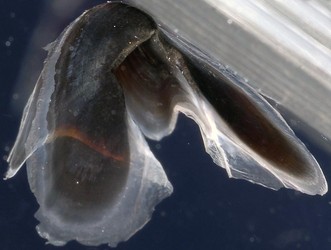
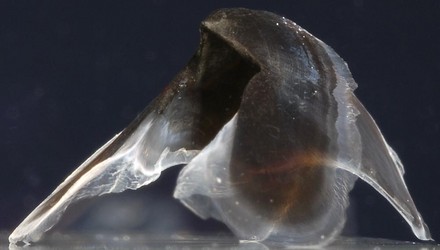
Figure. Oblique views of the lower beak of M. atlantica, 127 mm ML.

Figure. Oblique views of the lower beak of M. atlantica, 53 mm ML.

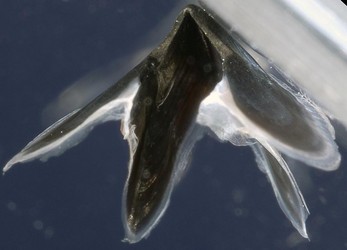
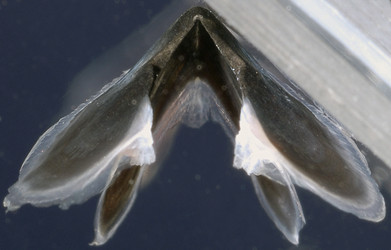
Figure. Oblique views of the lower beak of M. atlantica, 127 mm ML.

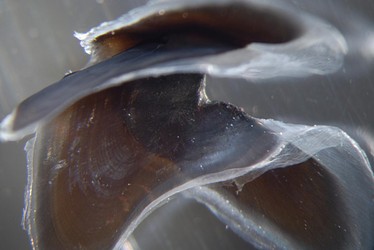
Figure. Oral-oblique views of the right and left jaw angles of M. atlantica lower beak.

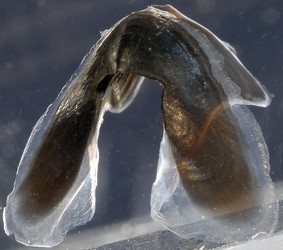
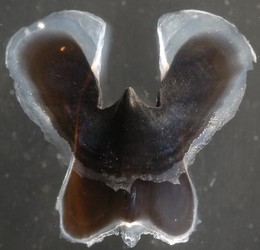
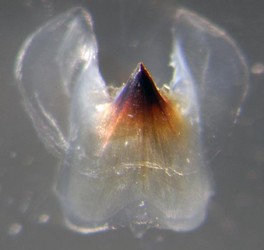
Figure. Views of the lower beak of M. atlantica. Left - Oblique view, 127 mm ML. Middle - Top view, 127 mm ML. Right - Top view, 53 mm ML.
Upper beak
Mature male, 127 mm ML: Upper beak with short, broad rostrum, hood high above crest, crest strongly curved. Lateral walls broadly spread. Lateral walls with strong undulation. Pallet virtually flat. Outer and inner shoulder blades blunt. Outer shoulder blade conceals inner blade when viewed laterally. Crest beneath hood without ridges. Outer rostral length/hood length = 0.20. Hood length/crest length = 0.55. Outer rostral length/hood height above crest = 0.73.
Juvenile male, 53 mm ML: Separation of inner and outer shoulder blades present only at extreme anterior end of shoulder; most of anterior margin of shoulder appears as a single blade. Rostral tip with distinct hook. Undulations of the lateral wall present but not as pronounced as in adult.
Upper beak photographs

Figure. Side views of the upper beak of M. atlantica. Left - 127 mm ML. Right - 53 mm ML, size is indicated by the tip of an insect pin in the photograph.

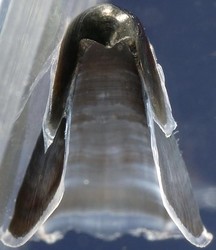
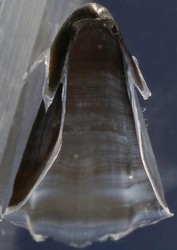
Figure. Frontal views of the upper beak of M. atlantica, 127 mm ML.

Figure. Oblique views of the shoulder and pallet of the upper beak of M.atlantica, 53 mm ML

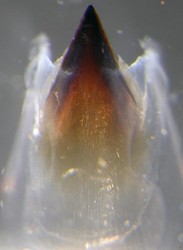
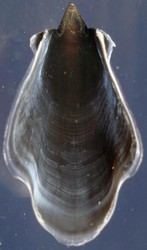
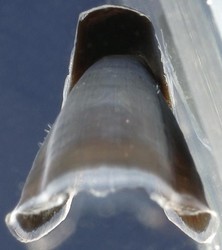
Figure. Views of the upper beak of M. atlantica. Left - Oral view, antrior end, 53 mm ML. Curve at bottom of photograph is the hood seen through the crest. Middle - Oral view, 127 mm ML. Right - Posterior view, 127 mm ML.
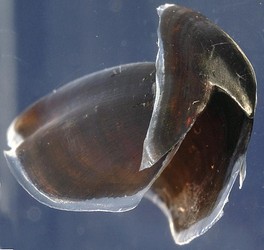
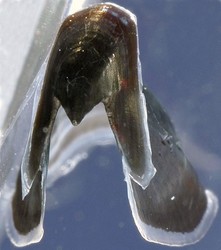




 Go to quick links
Go to quick search
Go to navigation for this section of the ToL site
Go to detailed links for the ToL site
Go to quick links
Go to quick search
Go to navigation for this section of the ToL site
Go to detailed links for the ToL site